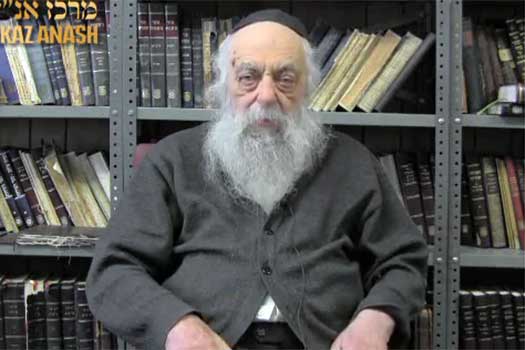
Reb Yoel Kahn: Learning Torah Like a Yid
Due to the overwhelming response and demand from the community, Reb Yoel Kahn agreed to present a weekly webcast on topics that are timely and relevant. This week’s topic is titled ‘Learning Torah Like a Yid’.
Reb Yoel Kahn, known to his thousands of students as “Reb Yoel,” serves as the head mashpia at the Central Tomchei Temimim Yeshivah in 770. For over forty years he served as the chief ‘chozer’ (transcriber) of all the Rebbe’s sichos and ma’amorim. He is also the editor-in-chief of Sefer HoErchim Chabad, an encyclopedia of Chabad Chassidus.
In response to the growing thirst of Anash for Chassidus guidance in day-to-day life, Reb Yoel has agreed to the request of Merkaz Anash to begin a series of short video talks on Yomei d’Pagra and special topics.
The video was facilitated by Beis Hamedrash L’shluchim, a branch of Merkos L’Inyonei Chinuch
Realizing the Torah’s Greatness
“And these are the laws that you shall place before them: If you buy a Jewish bondman…” Two questions arise: 1. Why is Ki sikneh expressed in the singular, when the possuk spoke of bnei Yisroel in the plural (lifneihem)? 2. Why is Ki sikneh expressed in thesecond person, when the possuk spoke of bnei Yisroel in the third person (lifneihem)?
Some mefarshim answer: The words Ki sikneh are expressed in the singular, andin thesecond person, because they are addressed not only to Bnei Yisroel at large, but also to Moshe Rabbeinu personally. They instruct him that he should teach the people Torah until they have actually acquired it (ki sikneh – “bought it”) and it becomes their own. Also: he should not teach briefly, but should explain and lay out its details before them (lifneihem), as on a set table. This instruction also applies to whoever teaches Torah over the generations.
Another meaning of Ki sikneh: Kiddush Levana refers to the Four Worlds, and the phrase that refers to the World of Atzilus is Baruch Konech, from the same root as Ki sikneh.When you teach Torah, you should enable your listener to acquire the understanding that the Torah he is learning is Atzilus. True, the World of Beriah is a lofty world, but it is nonetheless within the realm of creations. Ki sikneh teaches that he should have the feeling that Torah is higher than that: it is Elokus.
Understanding with Kabbalas Ol?!
This hints at another lesson that we can learn: Parshas Mishpatim starts off with the laws of acquiring an eved, a bondman. This is surprising, because the Torah generally relates to situations that commonly arise. Yet here the Torah speaks of the unusual situation in which a thief who is caught and cannot pay is sold, in order to cover his debt. There are so many other laws that relate to everyday situations. Why start precisely with this law?
Now, there are three kinds of mitzvos – mishpatim, eidos and chukim. Mishpatim are themitzvos whose rationale we can understand: Do not steal, Honor your father and mother, and the like.In fact, even without the Torah’s command, we could have arrived at these conclusions ourselves. Eidos are mitzvos such as eating matza, as a reminder of Yetzias Mitzrayim. Mortal reason would not obligate us to do this, but once the Torah explains it, we can understand it. Chukim: Even after the Torah explains them, they are beyond mortal understanding: “I have issued a decree…” So chukim are beyond our understanding, eidosare partly within the grasp of standing, and mishpatim can be understood.
How does our parsha begin its list of mishpatim? With the laws of an eved. From this we learn that even the subjects in Torah that we do understand, we should accept withkabbalas ol, like an eved. At the same time, however, we are commanded to understandthem! How can we sort this out?
The Torah is completely higher than Beriah: it is Atzilus – a kinyan, an acquisition of HaShem. It is the wisdom of HaKadosh Baruch Hu, “Whom no thought can grasp.” Yet He took this infinite wisdom, which no thought can grasp, and planted it in the Torah in a way that enables a Yid to study and grasp it.
The Gemara relates that King Talmai (Ptolemy) wanted to have the Torah translated for him. So he assembled 70 elders, and sat them down to work, each in isolation from his colleagues. Min HaShamayim it was arranged that all of them, independently, should make exactly the same emendations to their text. Their first change: They translated as if the first possuk did not say Bereishis bara Elokim, but Elokim bara Bereishis. Why the change? They were afraid that he might imagine that there existed some entity calledBereishis, and that entity created Elokim. This creates a problem.
The mefarshim are at pains to explain why the Torah begins with a beis and not with analef. Yet in the above translation, it starts off with an alef. That wasn’t why those translators made their change: they did it in order to avoid an idolatrous thought. However, this narration appears in the Gemara, so even if it is seemingly related in passing, it is a meaningful part of the Torah. How can we understand this change from the Torah’s beis to the translators’ alef?
Here is one explanation: The Torah is the wisdom of HaKadosh Baruch Hu, utterly beyond mortal reason, yet He lowered it to a level that enables a Yid to study and understand it. But the Yid should keep in mind that whatever he understands in the Torah is no more than abeis. The alef of Torah is that the Torah and HaKadosh Baruch Hu are one and the same, that the Torah is beyond mortal understanding. Yet that level has been brought to a level at which we can understand it. So what does he gain from this? He realizes that this is all beyond the grasp of his intellect. And that is the alef of Torah.
Which Torah Are We Learning?
People usually conceive of the process of tzimtzum of HaKadosh Baruch Hu’s chochmahas in the classic mashal of rav and talmid: since the rav cannot convey the full depth of his understanding to his talmid, he condenses some part of it in order to make it accessible. One might think that the same applies Above – that the Torah that HaKadosh Baruch Hustudies in Mesivta deRakia is the real Torah, and whatever lower echo of it that trickles down to us is something else.
This is not the case. Thus we say in birkas haTorah: venasan lanu es Toraso: He gave usHis Torah, the same Torah that is studied Above. When He chose us from all the nations and gave us His Torah, He filled it with all the lofty qualities that His Torah has. This is thealef of Torah. Although we don’t grasp it now, it is there in the Torah that we learn. Only later, in Gan Eden, and more so when Moshiach will come, we will comprehend it.
Who is able to do this? – The Yidden. He chose us from all the nations and gave us His Torah. When a Yid studies Torah, he considers whatever he understands in it as a beis.The alef is his awareness that the Torah is higher than his understanding: it is Toraso, the Torah of HaKadosh Baruch Hu. When a goy studies the very same mishna, such asShnayim ochazin betallis (two men grabbing a tallis), the bottom line for him is simplyyachloku (they divide it); that’s all there is in it for him. He doesn’t sense anything higher in it. That is why when the Chachomim translated the Torah for the gentile King Talmai, they had to start it with an alef, because that was as much as he could grasp.
An Essential Connection
Back to Ki sikneh: Those words are connected both with lifneihem – “you shall place before them,” and also to the concept of eved. The word lifneihem reminds a Torah teacher to deliver and set out his explanations conscientiously. At the same time, Ki siknehrelates to an eved, and thus serves as a reminder of the need for kabbalas ol. Ki siknehreminds us that the Torah is both a kinyan, an acquisition, and also belongs in Atzilus.
So when a Yid studies Torah, he’s not merely collecting another piece of information. Every word of Torah that a Yid learns makes him more eidl: it refines him and upgrades his connection with the Eibershter, with something that is utterly higher than his understanding. For a Yid, this is not a difficulty. This is his pnimiyus, his innermost essence, and this is hischayus, the source of his vitality. This is his kinyan, his acquisition: he knows that the Torah belongs in the World of Atzilus, and he has kabbalas ol that is higher than his level of existence. This doesn’t break him: this is what gives him chayus.














thank you!
Please keep this up. What an opportunity to learn from such a teacher! Chap a rein!
Very good article!!!!
Because Some teachers add to Torah & tie up heavy burdens and lay them on mens shoulders but they themselves are unwilling to move them with so much as a finger
more videos
there are many more videos of R’ Yoel available on youtube both in Hebrew and in Yiddish.
http://www.youtube.com/user/YoelKahn/videos
http://www.youtube.com/user/chassidutlekulam/videos?flow=grid&view=1